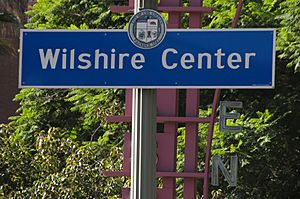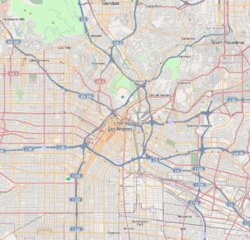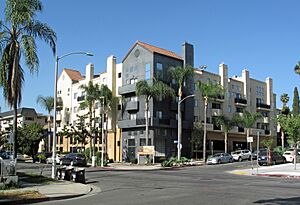Wilshire Center, Los Angeles facts for kids
Quick facts for kids
Wilshire Center
|
|
|---|---|

Wilshire Center neighborhood sign
located at the intersection of Wilshire Boulevard and Hoover Street |
|
| Country | |
| State | |
| County | |
| Time zone | Pacific |
| Zip Code |
90006
|
| Area code(s) | 213 |
Wilshire Center is a lively neighborhood located in the Wilshire area of Los Angeles, California. It's known for its many tall buildings and busy streets. This area has a rich history, from its early days as a quiet residential spot to becoming a major business hub. Today, it's a diverse community with lots of shops, restaurants, and places to live.
Contents
Where is Wilshire Center?
The name "Wilshire Center" is a newer way to describe this part of Los Angeles. It covers the eastern side of the Wilshire Community Plan area. This means it stretches from Virgil Avenue and Hoover Street in the east to Wilton Place and Crenshaw Boulevard in the west.
Wilshire Center shares its borders with other well-known neighborhoods. To the north, it meets Hollywood at Melrose Avenue. To the south, it borders Koreatown and a part of Harvard Heights. Historically, this whole area was simply called the Wilshire District. As Los Angeles grew, different parts of the district got their own names.
Some of the oldest parts of Wilshire Center were built in the early 1900s. These were called "streetcar suburbs" because people used streetcars to get around. Historic areas like Wilshire Park and Country Club Park are found here.
The main business part of Wilshire Center is generally between 3rd Street (north), 8th Street (south), Hoover Street (east), and Wilton Place (west). This is where many businesses and services are located.
Getting Around Wilshire Center
Wilshire Center is easy to get around thanks to its public transportation. You can catch city buses, including fast Metro Rapid lines. There are also three subway stations along Wilshire Boulevard.
The Metro D Line subway starts at Union Station in Downtown Los Angeles. It has stops at Vermont Avenue, Normandie Avenue, and Western Avenue. Currently, the D Line ends at Western Avenue. However, there are plans to extend it further west under Wilshire Boulevard to Westwood by 2027.
The Vermont station is also a stop for the Metro B Line. This line continues north through Hollywood all the way to North Hollywood.
A Look Back: History of Wilshire Center
Wilshire Boulevard is named after Henry Gaylord Wilshire. He was a wealthy man who, in 1895, started developing a large piece of land. This land stretched west from Westlake Park (now MacArthur Park). He wanted to create a fancy neighborhood there.
Wilshire was a socialist, which means he believed in sharing wealth and resources. He gave a strip of land to the city for a boulevard. He had two main conditions: it had to be named after him, and it could not have public transit, train lines, or commercial trucks.
This area was once known for its fancy shops and big company offices. In the early 1900s, cars powered by steam started sharing Wilshire Boulevard with horse-drawn carriages. At that time, parts of the area were still farmland. For example, Germain Pellissier raised sheep and barley, and Reuben Schmidt had a dairy farm.
By the mid-1990s, Wilshire Center faced some challenges, and many businesses left. But by 2001, the area had improved a lot. A big sign of this recovery was the opening of a large, modern spa, mall, and golf complex called Aroma Wilshire Center. This new center served the many Korean residents and business owners in the area.
Famous Buildings and Homes
Over the years, many tall apartment buildings and hotels were built along Wilshire Boulevard. One of the most famous was the lavish Ambassador Hotel. It opened in 1921 on what used to be Reuben Schmidt's dairy farm. The Academy Awards ceremony was even held there for a time.
The Ambassador Hotel closed in 1989 and was later torn down. Now, the Los Angeles Unified School District owns the land. In 2010, they opened the Robert F. Kennedy Community Schools and a small park on the site. This school is one of the most expensive public schools ever built in the United States.
Many elegant apartment buildings, like the Asbury, the Langham, and the Gaylord, were built nearby. Many famous movie stars used to live in these buildings.
Recently, there has been a building boom in the area. New apartments and condos are being built, and old office buildings are being turned into homes. This is partly because of city programs that encourage more housing near public transportation.
Shopping and Businesses
Wilshire Center has been home to many unique and important businesses.
In 1926, Gloria Swanson's husband, Herbert Somborn, opened the Brown Derby Restaurant. It was a famous hat-shaped building at Wilshire and Alexandria. Today, the hat sits on top of a restaurant in a small shopping center.
The elegant Art-Deco Bullocks Wilshire department store was built in 1929. It was the city's first branch department store located outside of downtown. It closed in 1993 and is now part of the Southwestern Law School library.
The Pellessier Building and Wiltern Theatre began construction in 1929. The theater, run by Warner Brothers, opened in 1931.
In 1929, the Chapman Market opened. It was the world's first drive-through grocery store, where people could shop from their cars.
Another major store, I. Magnin, opened in 1939.
In 1952, the first three 12-story Tishman Plaza buildings were built. These are now known as Central Plaza.
Many insurance companies also chose Wilshire Center for their West Coast offices. This was partly due to tax benefits from the state. From 1966 to 1976, about 22 tall office buildings were built on Wilshire Boulevard. These buildings housed companies like Getty Oil Co. and Equitable Life Insurance.
However, in the 1970s and 1980s, many businesses and wealthy residents started moving to less crowded areas. This caused rental prices to drop. Wilshire Center also faced challenges after the 1992 Los Angeles riots and the 1994 Northridge earthquake.
To help the area recover, the Wilshire Center Streetscape Project used government money to improve Wilshire Boulevard. This project was very successful and won an award in 1999.
Places of Worship
Wilshire Center is home to many different religious buildings. Wilshire Christian Church was the first church built on Wilshire Boulevard in 1911. The land for the church was given by the Chapman Brothers, who owned Chapman Market.
Other notable religious buildings include:
- Korean Philadelphia Presbyterian Church, on New Hampshire Avenue.
- The Los Angeles Korean Methodist Church, at 4th and Normandie.
- Immanuel Presbyterian Church (Wilshire & Berendo).
- First Congregational Church of Los Angeles (6th & Commonwealth).
- St. James Episcopal Church (Wilshire & St Andrews).
- First Baptist Church of Los Angeles (8th & Westmoreland).
- St Basil's Catholic Church, a modern building, on Wilshire.
- Founder's Church of Religious Science, on 6th Street.
- Wilshire Boulevard Temple (Reform Jewish).
- The Islamic Center of Southern California, a modern building, on Vermont.
Community Groups
The Wilshire Center/Koreatown Neighborhood Council (WCKNC) is a local group that helps the community. They work to improve the neighborhood and represent the people who live there.
Schools and Services
Children in Wilshire Center attend schools within the Los Angeles Unified School District. All high school students in the area go to Los Angeles High School.
Other schools in the neighborhood include:
- Los Angeles Elementary School
- Wilton Place Elementary School
- Berendo Middle School
- Burroughs Middle School
The Pio Pico–Koreatown branch of the Los Angeles Public Library is located at 7th and Oxford Streets. This is a great place for kids to find books and learn.
The Anderson-Munger branch of the YMCA of Metropolitan Los Angeles is at 3rd and Oxford Streets. The YMCA offers many programs and activities for young people.
Parks and Recreation
Wilshire Center does not have many large parks or community gardens. There are only small parks in the areas nearby. This means it is one of the parts of the city with the fewest green spaces.
Images for kids






